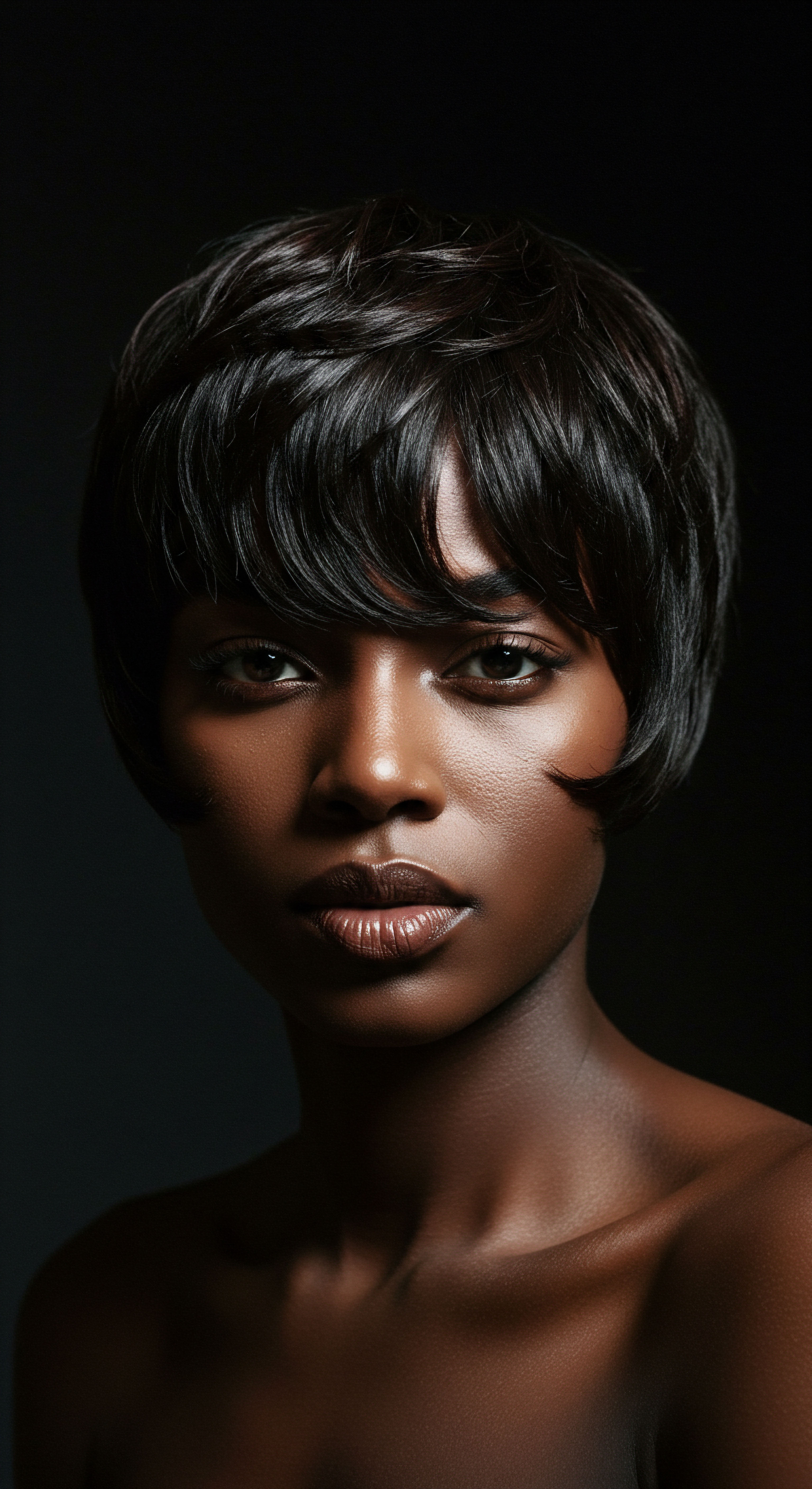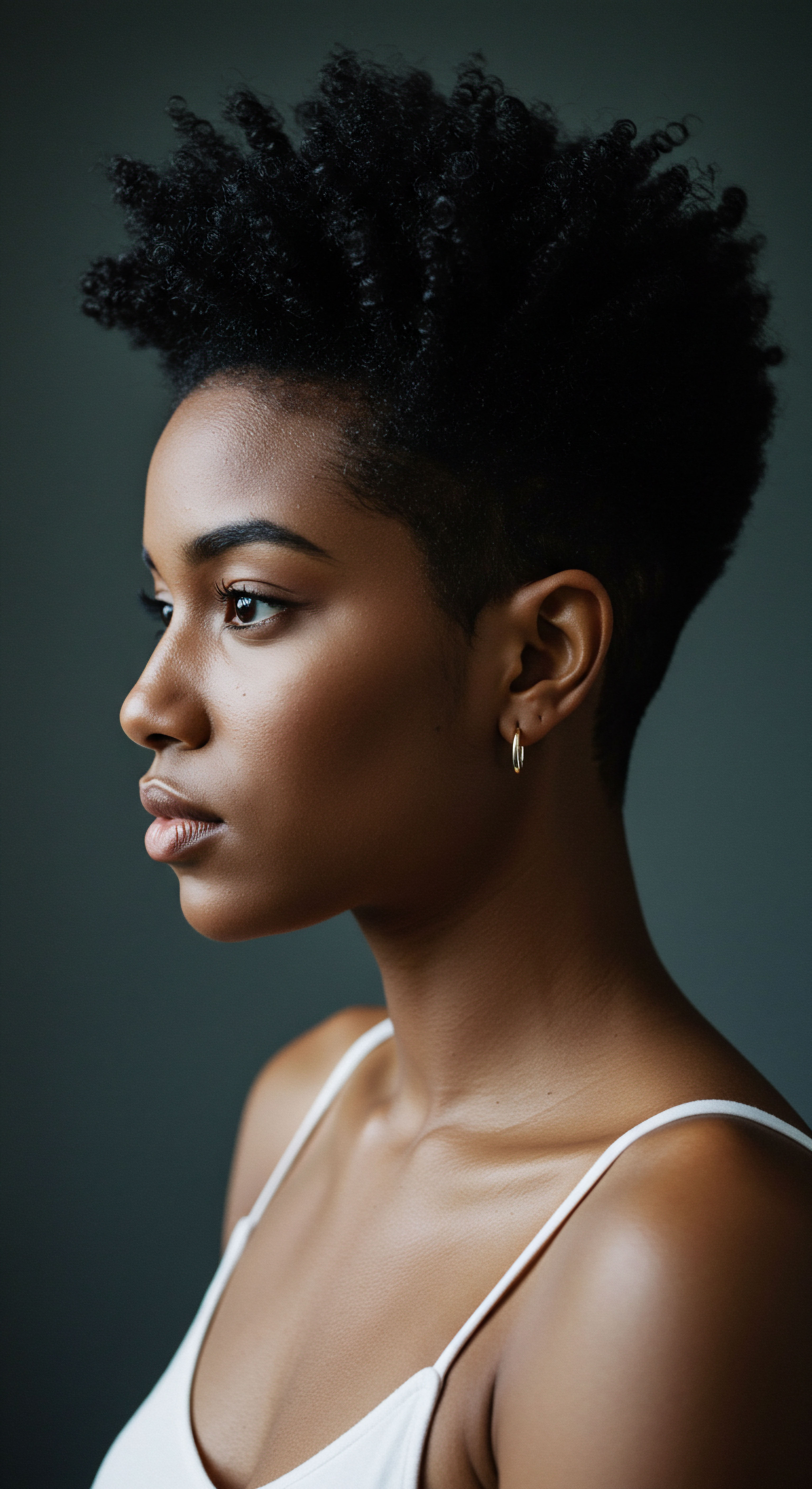
Roots
A quiet understanding often settles when we consider the enduring presence of the sleep bonnet within Black communities. It is not merely a piece of fabric, but a keeper of heritage, a testament to resilience, and a silent ally in the daily rituals of self-care. This simple accessory holds within its soft folds a rich narrative, deeply entwined with cultural practices, historical necessities, and a profound connection to hair as an extension of identity. To truly appreciate its widespread adoption, we must first look to the foundations, the very beginnings of textured hair care and its journey across continents and centuries.

A Legacy of Care from Ancestral Lands
Long before the transatlantic crossing, hair in African societies was a canvas of meaning. Hairstyles conveyed stories of age, marital status, wealth, and spiritual beliefs. They were intricate works, sometimes taking days to complete, and often involved communal styling sessions that deepened bonds between individuals. The hair itself was seen as a connection to the divine, the most elevated part of the body.
Protection of these elaborate styles, and the hair beneath them, was a practice born of both practical need and deep reverence. Natural butters, herbs, and powders were used for moisture retention, and scarves frequently served as coverings for ceremonies or daily protection from the sun and elements.
The displacement of African people during the transatlantic slave trade brought an abrupt and brutal disruption to these established traditions. Slaveholders often shaved the heads of captives, a deliberate act designed to strip away identity and culture. Despite this dehumanization, the spirit of hair care persisted.
Enslaved individuals, stripped of their traditional tools and ingredients, adapted with ingenuity, using what little was available to them. This period saw the rudimentary beginnings of head coverings as a means of protection from harsh labor conditions and as a quiet act of resistance.
The sleep bonnet, a seemingly simple accessory, holds a profound cultural story of adaptation and care for textured hair across generations.

The Shifting Sands of Hair Identity
Post-slavery, the pressure to conform to Eurocentric beauty standards became a powerful force. Straightened hair was often associated with social mobility and acceptance in a society that devalued natural Black hair. Yet, even as hot combs and chemical relaxers became common, the underlying need to preserve hairstyles remained.
Women would often straighten their hair for public appearance, but at night, a covering became essential to extend the life of these styles, avoiding the laborious process of re-straightening daily. This period cemented the bonnet’s practical role, moving it from a purely protective measure during harsh conditions to a tool for maintaining desired aesthetics in a world that often demanded conformity.
The cultural significance of hair in the Black community has always been complex, reflecting a constant negotiation between external pressures and internal affirmation. The sleep bonnet, in its quiet utility, became a consistent presence through these shifts, adapting its purpose while retaining its core function of care and preservation. It stands as a silent witness to centuries of hair journeys, from ancestral pride to forced assimilation, and ultimately, to a reclaiming of natural beauty.

Ritual
To truly appreciate the sleep bonnet, one must look beyond its simple form and consider the daily practices it supports, the mindful moments it helps preserve. The adoption of the sleep bonnet in Black communities is deeply tied to the ritualistic nature of Black hair care—a practice that extends far beyond mere grooming, touching upon self-expression, identity, and the practicalities of maintaining textured hair. It is within these routines, both personal and communal, that the bonnet finds its enduring purpose.

What Daily Realities Make Nighttime Protection So Important?
Textured hair, with its unique curl patterns and delicate structure, requires specific care to maintain its health and appearance. Unlike straighter hair types, curly and coily strands are prone to dryness and breakage. The friction of cotton pillowcases can strip moisture, cause tangles, and lead to frizz, undoing hours of styling and product application. This susceptibility makes nighttime protection not a luxury, but a vital step in a comprehensive hair care regimen.
Consider the time and effort invested in styling textured hair. Whether it is intricate braids, twists, locs, or a carefully defined wash-and-go, these styles demand significant commitment. For many, a styling session is a multi-hour affair, involving cleansing, conditioning, detangling, and applying specialized products to enhance curl definition and retain moisture.
To have these efforts undone by a single night’s sleep would be disheartening and impractical. The bonnet acts as a guardian, preserving the integrity of styles and extending their longevity, thereby saving time and resources.
The bonnet acts as a silent partner in the intricate dance of textured hair care, safeguarding styles and nurturing strands through the night.
The sleep bonnet, typically made of satin or silk, provides a smooth, low-friction surface for the hair to rest upon. This material helps to:
- Retain Moisture ❉ Unlike cotton, which absorbs moisture from the hair, satin allows hair to retain its natural oils and applied products, preventing dryness.
- Minimize Friction ❉ The smooth surface reduces rubbing against the pillow, which in turn reduces frizz, tangles, and breakage.
- Preserve Styles ❉ It keeps braids, twists, and other styles neat and undisturbed, allowing them to last longer and look fresh for multiple days.

How Do Practicalities Shape Cultural Practices?
The practical benefits of the sleep bonnet are undeniable, and these practicalities have, over time, shaped and solidified its cultural standing. The collective experience of needing to protect textured hair from damage and maintain styles efficiently has woven the bonnet into the fabric of daily life for many Black individuals. It has become a standard tool, passed down through generations, often alongside the very techniques it helps preserve.
This cultural adoption is also influenced by economic considerations. The Black hair care industry is a significant market, with Black women spending a considerable amount on hair products and services. For instance, Black women spend approximately six times more on hair care than other ethnic groups, contributing substantially to the beauty market.
Preserving a hairstyle with a bonnet extends its life, reducing the frequency of salon visits or the need for more products, offering a subtle but meaningful economic benefit. This practical saving reinforces the bonnet’s utility and desirability within communities where hair care is both an investment and a statement.
The act of putting on a bonnet at night becomes a quiet ritual, a moment of intentional care that prepares hair for the next day. It is a testament to the dedication involved in maintaining textured hair, acknowledging its unique needs and celebrating its beauty through protective measures. This routine is a blend of scientific understanding of hair structure and cultural wisdom passed down through families, creating a shared practice that binds communities.
| Protection Method Satin/Silk Bonnet |
| Primary Benefit Moisture retention, frizz prevention, style preservation |
| Hair Type Suitability All textured hair, especially coily, curly, wavy |
| Protection Method Satin/Silk Pillowcase |
| Primary Benefit Reduced friction, less breakage, cooler sleep surface |
| Hair Type Suitability All hair types, complementary to bonnets |
| Protection Method Pineapple Method |
| Primary Benefit Volume preservation, curl definition maintenance |
| Hair Type Suitability Curly and wavy hair |
| Protection Method Braids/Twists for Sleep |
| Primary Benefit Stretch hair, create waves/curls, minimize tangles |
| Hair Type Suitability All textured hair |
| Protection Method These methods collectively aim to preserve hair health and style overnight. |

Relay
Beyond its practical utility and historical roots, the sleep bonnet’s pervasive presence in Black communities speaks to deeper currents of cultural intelligence, a profound understanding of self, and the collective experience of identity. Its adoption is not a singular phenomenon but a complex interplay of historical trauma, communal resilience, and a quiet yet potent act of self-affirmation in a world that has often sought to diminish Black beauty. To truly comprehend its widespread acceptance, we must consider the societal pressures and the psychological dimensions that elevate this simple accessory to a cultural touchstone.

How Does Hair Discrimination Shape Protective Practices?
The historical and ongoing discrimination against Black hair textures plays a significant, if often unspoken, role in the adoption of protective measures like the sleep bonnet. From the era of slavery, where African hair was deemed “unprofessional” or “uncivilized,” to contemporary workplace biases, Black individuals have faced immense pressure to conform to Eurocentric beauty standards. This societal policing of hair has created a persistent need for strategies that both protect natural hair and allow for versatility in presentation.
Research indicates that Black women are disproportionately affected by hair discrimination. A study sponsored by Dove, cited in academic discussions, reported that Black women are 3.4 times more likely to be labeled unprofessional due to their hair presentation and 1.5 times more likely to be sent home from work due to “unprofessional hair.” This stark reality underscores the systemic nature of hair bias, where natural textures and traditional Black hairstyles are often met with disapproval in professional and educational settings. In response, many Black women feel compelled to alter their natural hair texture, often through chemical or heat treatments, to align with organizational norms.
The widespread use of the sleep bonnet is a testament to the community’s response to historical hair discrimination and the ongoing pursuit of hair health and dignity.
This pressure to conform, paradoxically, strengthens the need for protective measures. When hair is straightened or styled to meet external expectations, preserving that style becomes even more critical to avoid daily re-styling, which can lead to damage. The bonnet thus serves as a silent act of defiance and self-preservation, allowing individuals to maintain their chosen appearance with minimal disruption and further harm to their strands. It provides a sanctuary for hair, away from the scrutiny and demands of the outside world, allowing it to rest and retain its integrity.

What Psychological and Communal Bonds Are Forged Through Hair Care?
The act of caring for Black hair extends beyond the physical, touching upon deep psychological and communal dimensions. Hair care routines, including the use of a sleep bonnet, can be a form of self-love and self-compassion, particularly in contexts where cultural identity and self-expression intersect with personal growth. This intentionality in care can be a soothing exercise, offering moments of mindfulness and a sense of control in a world that often attempts to dictate appearance.
For many Black women, hair care is also a powerful act of connection. Historically, and continuing today, hair styling has been a communal activity, strengthening bonds between mothers, daughters, sisters, and friends. These shared experiences build a sense of worth and belonging. The discussions that happen during hair care sessions often extend to broader life topics, making salons and homespaces where hair is tended to unofficial centers of support and emotional well-being.
The bonnet, as a tool used within this communal and personal ritual, absorbs some of this shared meaning. It is not just about hair protection; it is about protecting a piece of cultural identity, a sense of belonging, and the emotional investment in self-care.
The cultural adoption of the sleep bonnet, therefore, is not merely a response to hair texture’s needs. It is a multifaceted phenomenon, a product of centuries of adaptation, resistance to oppressive beauty standards, and the deep-seated cultural value placed on hair as a symbol of identity and resilience. The bonnet, in its quiet utility, allows for both personal well-being and a continuity of cultural practice, a relay of wisdom from one generation to the next.
Consider the financial implications tied to this cultural practice. While Black women spend more on hair care, this spending also reflects a market that has historically underserved their unique needs, forcing innovation and entrepreneurial spirit within the community. The rise of Black-owned beauty brands, though still a small percentage of the overall market, is a testament to this self-sufficiency. The bonnet, a relatively low-cost protective item, offers a way to maximize the investment in more expensive styling products and services, acting as a smart economic decision within a system that often penalizes Black hair.
- Hair as Identity ❉ The connection between hair and identity for Black individuals is profound, representing cultural heritage, resilience, and self-affirmation.
- Community Bonding ❉ Hair care practices often serve as communal activities, strengthening social ties and providing spaces for shared experience and emotional support.
- Resistance to Standards ❉ Wearing natural hair or utilizing protective styles can be an act of resistance against Eurocentric beauty norms and societal pressures.

Reflection
The widespread adoption of the sleep bonnet in Black communities stands as a testament to ingenuity, perseverance, and a profound connection to self. It is a story told not in grand pronouncements, but in the quiet, consistent act of preparing one’s hair for rest. This seemingly simple item transcends its material form, embodying centuries of cultural memory, practical adaptation, and a deeply personal commitment to well-being.
It speaks to a collective wisdom that understands the unique needs of textured hair, the historical forces that have shaped its perception, and the enduring power of ritual in nurturing both outer appearance and inner spirit. The bonnet, then, is more than just a cap for the night; it is a gentle whisper of heritage, a soft shield against the world’s harshness, and a daily affirmation of beauty, resilience, and self-care that continues to unfold with each new dawn.

References
- Byrd, Ayana, and Lori L. Tharps. Hair Story ❉ Untangling the Roots of Black Hair in America. St. Martin’s Press, 2001.
- Mercer, Kobena. Welcome to the Jungle ❉ New Positions in Black Cultural Studies. Routledge, 1994.
- Mbilishaka, Afiya. “PsychoHairapy ❉ Using Hair as an Entry Point into Black Women’s Spiritual and Mental Health.” Journal of Black Psychology, 2018.
- Rooks, Noliwe M. Hair Raising ❉ Beauty, Culture, and African American Women. Rutgers University Press, 1910.
- Thompson, Cheryl. “Black Women and Identity ❉ A Critical Analysis of the Black Hair Care Industry.” Critical Arts, vol. 22, no. 1, 2008, pp. 29-47.
- White, Shane, and Graham White. “Slave Hair and African American Culture in the Eighteenth and Nineteenth Centuries.” The Journal of Southern History, vol. 61, no. 1, 1995, pp. 1-46.
- Dove. The CROWN Act Research Study. Dove, 2019.
- Mintel. Black Haircare Market Report US. Mintel, 2023.
- Esmaeilpour, Niloufar. “Hair and Mental Health ❉ The Overlooked Link.” Lotus Therapy & Counselling Centre, 2024.
- Rowe, Kristin. “Black Women’s Natural Hair Care Communities ❉ Social, Political, and Cultural Implications.” California State University, Fullerton, 2021.